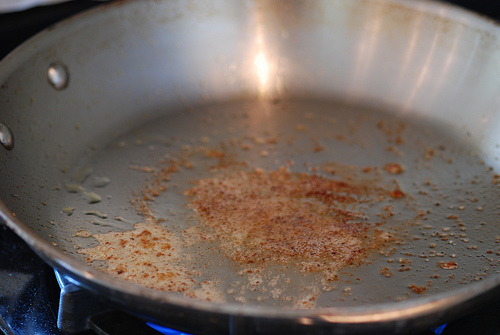Sesame seeds are pretty awesome little critters, especially when they’re toasted. They’re packed with flavor, copper, manganese, calcium, iron, and so much more. They can be used in anything from stir-fry, to bread, to smoothies. You’ve probably noticed them all over in Asian-themed foods and in salads.Continue Reading
How to Deglaze Your Pans + Recipe
 Deglazing a pan is the key to making delicious sauces and gravies for your meats and vegetables. After cooking meat or vegetables instead of scrapping all the leftover fat and dregs into a grease jar, make it into a divine sauce. Deglazing a pan is simply adding stock, lime juice, water, or some other liquid to break up and dissolve the dregs left over from sauteing, searing, or roasting. I especially like to deglaze my cast iron pans, as it helps the cast iron’s flavor–not that I eat cast iron or anything.
Deglazing a pan is the key to making delicious sauces and gravies for your meats and vegetables. After cooking meat or vegetables instead of scrapping all the leftover fat and dregs into a grease jar, make it into a divine sauce. Deglazing a pan is simply adding stock, lime juice, water, or some other liquid to break up and dissolve the dregs left over from sauteing, searing, or roasting. I especially like to deglaze my cast iron pans, as it helps the cast iron’s flavor–not that I eat cast iron or anything.
If you haven’t deglazed your pans before, now’s a good time to get started. You’ll be surprised how well you can get the junk off your pan when doing so ad also the delicious sauces you can make. So for starters, here’s how to deglaze your pots and pans and make a delicious sauce.
Continue Reading
How to Sauté Meats and Vegetables
Let’s begin with some trivia. The word “Sauté”, as you can probably guess, is French. It’s derived from the French word sauter which means to jump. It refers to the food flipping in the pan by giving the pan a quick shake. I expect you to have this technique mastered by the end of next week.
Sautéing food is a simple technique that you can’t do without. You can cook dozens of meats and vegetables by sautéing them. To sauté is simply to cook food in a small amount of oil or fat in over fairly high heat in a short amount of time, usually in a shallow sauté pan. Don’t confuse this with searing. Searing is meant to brown only the outside of the meat, whereas sautéing cooks the inside of the meat. Because most stovetops are different, I recommend beginning at a medium-high heat and adjust the temperature from there.
To properly sauté your food
- Preheat your pan before adding anything. Preheating your pan first helps the heat to disperse more evenly and keeps any oils or fats from burning on a hot spot.
- Make sure the surface of your meats or vegetables are dry; you don’t want to steam or stew your dish accidentally.
- Add your oil or fat. You can use butter, but it has a lower burning point and may burn early. If you do use butter, make sure the butter bubbles in the pan before adding your food. I would recommend sautéing with a higher smoking point oil, like olive oil or canola oil.
- Your meats should sizzle (I love that word) when they first touch the pan. Once again, don’t get your pan too hot because you don’t want to sear your food.
- When sautéing meats, don’t break the surface of the meat with a knife or fork, because that lets the moisture escape. The overall goal of sautéing is to quickly cook your food without letting too much moisture out. When you need to flip the meat, use a spatula or tongs instead.
- When sautéing vegetables, start sautéing the hardest vegetables first. Add the softer vegetables in later so that they can be done at the same time. You may want to consider blanching or steaming some harder vegetables before sautéing them (e.g. carrots and cauliflower).
- Add salt towards the end. Salt sucks out moisture from the meats and vegetables. This seems to have a bigger affect on you sautéd vegetables, and especially sautéd mushrooms.
- Don’t stir or flip the food in your pan too often as it lengthens the sautéing process.
Note that for best results when sautéing meats, use a tender cut such as tenderloin, filet mignon, or pork chops.
Do you have any great sautéing tips or stories? Share them in the comments below.

